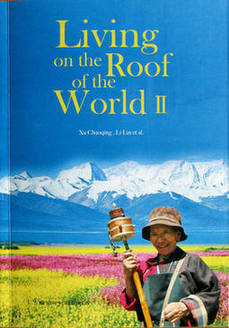By LI CHENXI

Title: Living on the Roof of the World (II)
Authors: Xu Chaoqing, Li Lin et al.
Price: RMB 78
Published by New World Press, Beijing, 2013
By LI CHENXI

Title: Living on the Roof of the World (II)
Authors: Xu Chaoqing, Li Lin et al.
Price: RMB 78
Published by New World Press, Beijing, 2013
The 1,300-year-old Jokhang Monastery in Lhasa is bathed in morning sunshine. Rainbow hued prayer banners flutter on towering gilded flagpoles as smoke spirals from incense burners. Drolma Lhamo, in her late 70s, fingers her prayer beads as she makes her morning devotions, just as she has done for decades.
Drolma Lhamo lives deep in the labyrinthine alleys of Barkhor Street. Born in a traditional courtyard residence there, she moved out of the neighborhood when she was 27 to take up work in another location. Upon retiring 25 years ago, she returned to her birthplace. Although her life had reverted to its starting point, everything there had changed. What was a dirt road is now paved with stone slabs and lit by street lamps. Some residences have transformed into shops with signboards in Chinese and English as well as Tibetan.
In a store not far from Drolma’s home, Li Ou is stringing turquoise bracelets. After graduating from art school six years earlier, Li found a job in Lhasa. She first sold the bracelets and necklets that she had designed in her spare time, and eventually saved enough to open her own business – a shop of around a dozen square meters. It nonetheless gave Li inspiration and a platform to realize her artistic dreams. She is one of many young people who have come to Tibet from all over China. They either work for modest salaries or open small businesses. In their free time they stroll in the sun by the Jokhang Monastery or chat with friends in sweet-tea houses, enjoying the leisurely life of Tibet.
Yumai is a remote township by the China-India border that consists of eight households of 35 people, all Tibetan. A bright five-star red flag is hoisted from every rooftop. From 1983 to 1995 only one family – that of then township head Sanjay Quba – lived here. After his wife died, Sanjay and his two daughters moved out. But after just three months, they came back. He told the girls: “If we leave, nobody will stay here.”
Drolma, Li Ou and Sanjay Quba live ordinary lives in Tibet. They are the main characters in Living on the Roof of the World (II). The religious, geographical and historical aspects of Tibet give it an aura of mystique that impresses people. Some regard it as an idyllic land or spiritual home; others believe it has been polluted by commercialization. There is a wide range of books on Tibet, its geography, history, tourism, and customs. But mysticism, which actually diverts readers even further from the reality of Tibet, constitutes much of the hype on this mountainous outpost. Having published Living on the Roof of the World in 2011, New World Press has now published its sequel. The book series depicts the real lives of everyday Tibetans, their weals and woes, and gives outsiders a glimpse of so-called mysterious Tibet.